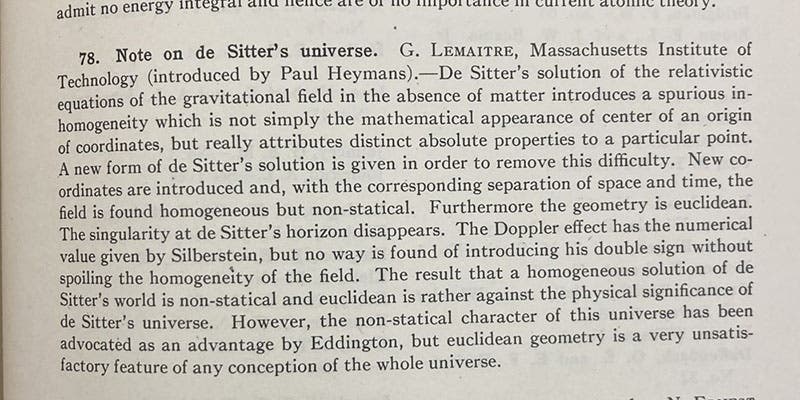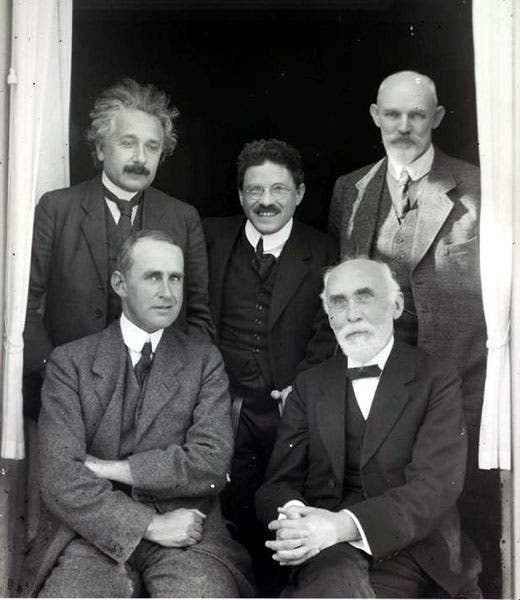Scientist of the Day - Willem de Sitter
Willem de Sitter, a Dutch mathematician and astronomer, died Nov. 20, 1934, at age 62. De Sitter was educated at the University of Groningen, and was appointed chair of the department of astronomy at Leiden University in 1908. He became director of the Leiden Observatory in 1919.
De Sitter was unusual in that he was comfortable working as a mathematician, a physicist, and an astronomer, which means he was one of the few capable of appreciating and applying Albert Einstein's theory of special relativity, proposed in 1905, and his theory of general relativity, published in 1916. De Sitter published a paper in 1911, pointing out the implications of special relativity for astronomy, and several more arguing for the constancy of the speed of light. Then when Einstein, in 1917, published a paper applying his equations of general relativity to cosmology, de Sitter entered the ring. Einstein proposed a model of the universe that was infinite but closed by the curvature of space. Space was curved by the presence of matter, and the amount of matter determined the curvature, and hence the size of the universe, for which Einstein had some estimates. Einstein’s universe was also static, meaning it did not expand or contract.
De Sitter's response came in the form of three papers in 1917, written for the Monthly Notices of the Royal Astronomical Society in England, all with the same general title: "On Einstein's theory of gravitation and its astronomical consequences.” These papers, written in English, in effect introduced general relativity to English astronomers and mathematicians, since the Great War was still going on and normal scientific channels between Germany and England were cut off. De Sitter showed that there was another cosmological solution to the equations of general relativity besides Einstein’s model, one in which the universe is also static, but now empty of matter. He called this Solution B to the equations of general relativity. That seemed physically absurd to Einstein, even if it was mathematically sound, for it is matter that curves the universe in the first place. But in his third paper, de Sitter pointed out an interesting feature of his empty universe – if you introduced a particle of matter, it would recede from the observer. This was the first inkling that the universe might not be so static after all (second image).
The de Sitter cosmology did not go away. After the war, astronomers in both England and the United States made rapid strides with their new telescopes, discovering, among other things, that most of the spiral nebulae have red shifts, meaning that they are receding from us, some at very high velocities. In 1925, the Belgian astronomer and mathematician Georges Lemaître gave a paper in the United States in which he critiqued de Sitter’s static universe and suggested a correction that would make the universe non-static. Physical Review published an abstract of his paper (third image). And he followed up in 1927 with his (now) famous paper, in which he proposed that the universe is expanding (see our post on Lemaître). This was two years before Edwin Hubble discovered his law that implies that galaxies are moving away from each other with increasing speed as they recede from our vantage point. It seems that de Sitter’s universe provided more of a stimulus than Einstein’s for Lemaître 's cosmological conclusions.
It is sometimes said that Einstein and de Sitter sparred over their respective cosmologies, in papers and in correspondence, but there is no evidence of this. The two did collaborate on a paper in 1933, but this was after the expanding universe had been more or less accepted by cosmologists and astronomers alike. How de Sitter would have reacted to further discussions we will never know, for he died in 1934, at the relatively young age of 62.
The best discussion of de Sitter, and of cosmology in the 1920s, is in Helge Kragh’s Cosmology and Controversy: The Historical Development of Two Theories of the Universe (1996). But although Kragh welcomed a general audience, he wrote primarily for a readership of scientists and historians, and his book, although authoritative, can be heavy going for even a well-educated reader. An alternative is The Day without Yesterday: Lemaître, Einstein, and the Birth of Modern Cosmology (2005), by John Farrel, which is written expressly for a general audience, and provides clear discussions of what can be a complicated subject. De Sitter’s role in the launch of 20th-century cosmology is thoroughly discussed in both books.
William B. Ashworth, Jr., Consultant for the History of Science, Linda Hall Library and Associate Professor emeritus, Department of History, University of Missouri-Kansas City. Comments or corrections are welcome; please direct to ashworthw@umkc.edu.










